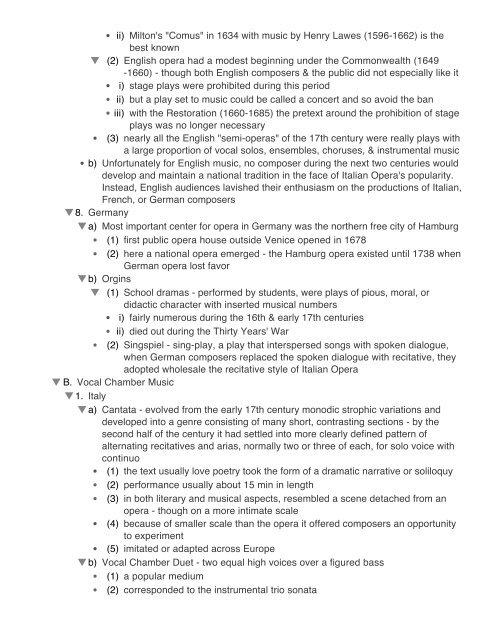An Outline of The History of Western Music Grout ... - The Reel Score
An Outline of The History of Western Music Grout ... - The Reel Score
An Outline of The History of Western Music Grout ... - The Reel Score
You also want an ePaper? Increase the reach of your titles
YUMPU automatically turns print PDFs into web optimized ePapers that Google loves.
ii) Milton's "Comus" in 1634 with music by Henry Lawes (1596-1662) is the<br />
best known<br />
(2) English opera had a modest beginning under the Commonwealth (1649<br />
-1660) - though both English composers & the public did not especially like it<br />
i) stage plays were prohibited during this period<br />
ii) but a play set to music could be called a concert and so avoid the ban<br />
iii) with the Restoration (1660-1685) the pretext around the prohibition <strong>of</strong> stage<br />
plays was no longer necessary<br />
(3) nearly all the English "semi-operas" <strong>of</strong> the 17th century were really plays with<br />
a large proportion <strong>of</strong> vocal solos, ensembles, choruses, & instrumental music<br />
b) Unfortunately for English music, no composer during the next two centuries would<br />
develop and maintain a national tradition in the face <strong>of</strong> Italian Opera's popularity.<br />
Instead, English audiences lavished their enthusiasm on the productions <strong>of</strong> Italian,<br />
French, or German composers<br />
8. Germany<br />
a) Most important center for opera in Germany was the northern free city <strong>of</strong> Hamburg<br />
(1) first public opera house outside Venice opened in 1678<br />
(2) here a national opera emerged - the Hamburg opera existed until 1738 when<br />
German opera lost favor<br />
b) Orgins<br />
(1) School dramas - performed by students, were plays <strong>of</strong> pious, moral, or<br />
didactic character with inserted musical numbers<br />
i) fairly numerous during the 16th & early 17th centuries<br />
ii) died out during the Thirty Years' War<br />
(2) Singspiel - sing-play, a play that interspersed songs with spoken dialogue,<br />
when German composers replaced the spoken dialogue with recitative, they<br />
adopted wholesale the recitative style <strong>of</strong> Italian Opera<br />
B. Vocal Chamber <strong>Music</strong><br />
1. Italy<br />
a) Cantata - evolved from the early 17th century monodic strophic variations and<br />
developed into a genre consisting <strong>of</strong> many short, contrasting sections - by the<br />
second half <strong>of</strong> the century it had settled into more clearly defined pattern <strong>of</strong><br />
alternating recitatives and arias, normally two or three <strong>of</strong> each, for solo voice with<br />
continuo<br />
(1) the text usually love poetry took the form <strong>of</strong> a dramatic narrative or soliloquy<br />
(2) performance usually about 15 min in length<br />
(3) in both literary and musical aspects, resembled a scene detached from an<br />
opera - though on a more intimate scale<br />
(4) because <strong>of</strong> smaller scale than the opera it <strong>of</strong>fered composers an opportunity<br />
to experiment<br />
(5) imitated or adapted across Europe<br />
b) Vocal Chamber Duet - two equal high voices over a figured bass<br />
(1) a popular medium<br />
(2) corresponded to the instrumental trio sonata<br />
c) Serenata - a semi dramatic piece usually written for some special occasion<br />
performed by a small orchestra and several singers





